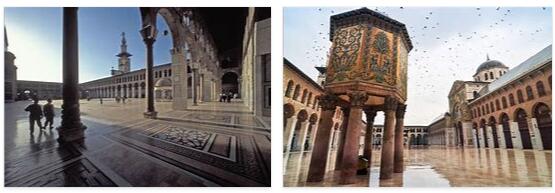Old City of Damascus (World Heritage)
Damascus is one of the oldest cities in the Middle East. Numerous cultures and conquerors left their mark on the cityscape, such as the Greeks, Romans and Byzantines, but above all the Umayyad dynasty. Damascus is also closely linked to the history of Christianity and Islam. The outstanding buildings of the medina include the Omaijad Mosque, built in the 8th century, the medieval hospital, Saladin’s tomb, and the Ananias and Paul Chapel. The covered souk also exudes medieval flair.
Old City of Damascus: Facts
| Official title: | Old City of Damascus |
| Cultural monument: | Medina with eight city gates such as the Bab Tuma and 125 monuments, including the Great or Umayyad Mosque, the Bimaristan Nur ad-Din hospital from the Middle Ages; the madrasah Zahiriye, the tomb of Saladin, the bitter opponent of the crusaders, the 12th century bath Nur ad-Din, the Ananias and Paulus chapels |
| Continent: | Asia |
| Country: | Syria |
| Location: | Damascus |
| Appointment: | 1979; on the Red List of World Heritage in Danger since 2013 |
| Meaning: | one of the oldest cities in the Middle East closely linked to the history of Christianity and Islam |
Old Damascus: history
| 1470 BC Chr. | mentioned in a document on an Egyptian hieroglyphic tablet |
| 332 BC Chr. | Conquest by the troops of Alexander the Great |
| 64 BC Chr. | Entry of the Romans |
| 7th / 8th Century | Seat of the Umayyad caliphs |
| 705-15 | Construction of the Great Mosque |
| 1401 | Invasion of the Mongols, deportation of the artistic and intellectual elite to Samarkand |
| from 1516 | Ottomans take over the city for the next 400 years |
| 1898 | Visit of Kaiser Wilhelm II. |
| 1920 | Seat of the French mandate government of the League of Nations |
| 1946 | Withdrawal of the French troops |
Maybe a piece of paradise…
“Damascus – God protect it! – Damascus, the paradise of the Orient, whose splendor shines all over the world, a symbol of the countries of Islam, young bride whom we admired, adorned with fragrant flowers and plants, wrapped in the brocade robe of her gardens, ”enthused the Andalusian Mecca pilgrim Ibn Jubair when he visited the oasis city in the 12th century. Another Arab traveler, Ibn Batutta, also found words of enthusiasm for this city, which is said to have housed the Messiah and his mother: “If there is paradise on earth, then Damascus is undoubtedly one of them; and if paradise is in heaven, then Damascus is its earthly counterpart. ”
The thought of a paradise may be related to the favor of the location, since Damascus is located in a particularly water-rich and fertile oasis, but it certainly also has religious motives. The Muslim legend sees Damascus as the birthplace of the patriarch Abraham. The footprints of the Prophet Mohammed are shown in a southern suburb, and the Jesus minaret of the Great Mosque is considered to be the place where Jesus, venerated as a prophet in Islam, will rise from heaven before the Last Judgment to fight the fight against the To accept Christians. For the Syrian Christians, on the other hand, the “Pearl of the Orient” has a special religious charisma because the head of John the Baptist is buried here and Saul turned into Paul. The Umayyad Mosque is the religious center of the old town. Its prehistory begins with the first sacred building on the site of today’s mosque, an Aramaic temple. The Romans built the huge temple complex of Jupiter Damascenus, of which some courtyard walls and a gate are still preserved. The Christianized Damascus, in turn, replaced the temple with a St. John’s Church, which was transformed into a mosque in the 8th century under the caliph al-Walid, the basic shape of which has been preserved despite later renovations. Divided into a three-aisled, transverse prayer hall and a wide courtyard with arcades, it is one of the pioneering building works of Islam. The mosaics, which take up the paradise theme and show a fertile river landscape with architectural groups and trees, are particularly valuable. The Christianized Damascus, in turn, replaced the temple with a St. John’s Church, which was transformed into a mosque in the 8th century under the caliph al-Walid, the basic shape of which has been preserved despite later renovations. Divided into a three-aisled, transverse prayer hall and a wide courtyard with arcades, it is one of the pioneering building works of Islam. The mosaics, which take up the paradise theme and show a fertile river landscape with architectural groups and trees, are particularly valuable.
The Umayyad Mosque is surrounded by important monuments of the Islamic Middle Ages. The three great Muslim fighters against the Crusaders, Nur ad-Din, Saladin and Baibars, are buried here. The Bimaristan des Nur ad-Din bears witness to the beneficial work of these rulers of the 12th and 13th centuries: a hospital built in 1154, with a permanent medical staff and departments for surgery, orthopedics, fever and mental illnesses far beyond the contemporaneous institution of the western infirmary protruded. Religious schools (madrasas) like the Nuriye from the 12th century served to consolidate the Islamic creed. The bath of Nur ad-Din, built in the 12th century and still a popular meeting place for Damascus merchants to this day, refers to the city’s excellent water supply.
The bustling heart of old Damascus still beats in the bazaar, in the souk. However, gunsmiths and horse dealers have long since disappeared in Souk al-Hamidye after modernization in the 19th century. The barrel roof made of corrugated iron with the “artificial starry sky” is a reminder of the Druze uprising of 1925, when the French ransacked the roof of the souk with volleys from their machine guns. The extensive khans like Khan Assad Pasha served the wholesale and foreign trade merchants as warehouses and offices. They are still sold individually at stalls and in small workshops. There is the district of the cloth merchants, the carpet souk, and finally the book bazaar, which runs towards the spiritual center of Damascus, to the Umayyad mosque. Workshops like those of the tinsmiths and tanners, from which noise or odor nuisance emanates, have been banished to the outskirts out of understandable caution. Because of the ongoing civil war, the old town of Damascus has been on the Red List of World Heritage in Danger since 2013.



